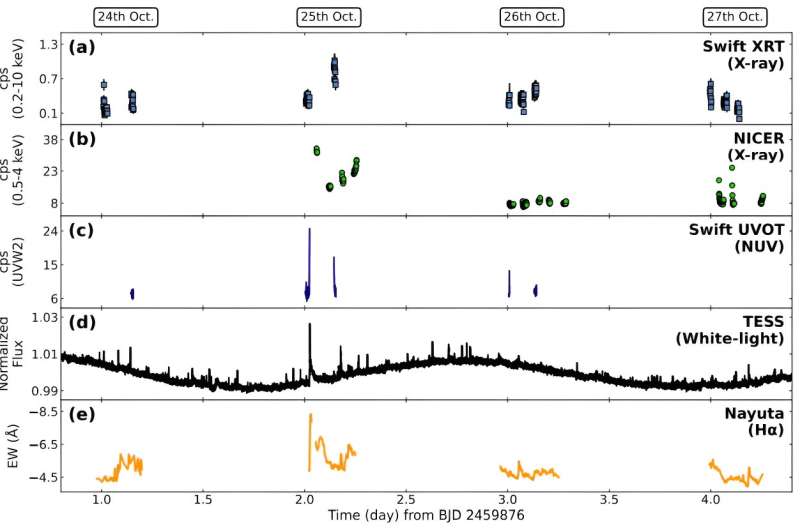January 10, 2024 report
This article has been reviewed according to Science X's editorial process and policies. Editors have highlighted the following attributes while ensuring the content's credibility:
fact-checked
preprint
trusted source
proofread
New large stellar flare detected from EV Lacertae

Astronomers have performed multiwavelength observations of a nearby M-dwarf star known as EV Lacertae (or EV Lac for short). The observational campaign resulted in the detection of a new large stellar flare from this object. The finding was detailed in a paper published December 31 on the pre-print server arXiv.
Stellar flares are energetic and impulsive releases of large amounts of energy from a star. They occur when a shift in the star's magnetic field accelerates electrons to speeds approaching that of light, which results in eruptions producing emission across the entire electromagnetic spectrum.
Observations show that flares from M-dwarf stars provide some of the most dramatic stellar events; however, they are difficult to predict. Spotting such activity on this type of object requires long-duration measurements of many stars.
Now, a team of astronomers led by Shun Inoue of the Kyoto University in Japan reports the detection of a new flare from such a star. In October 2022, they performed multiwavelength observations of EV Lacertae (also known as GJ 873)—an active and faint M dwarf of spectral type M4.5 located about 16.5 light years away.
"We conducted 4-night multiwavelength observations of an active M-dwarf star EV Lacertae on October 24–27, 2022 with simultaneous coverage of soft X-rays (NICER; 0.2−12 keV, Swift XRT; 0.2−10 keV), near-ultraviolet (Swift UVOT/UVW2; 1,600−3,500 Å), optical photometry (TESS; 6,000−10,000 Å), and optical spectroscopy (Nayuta/MALLS; 6,350−6,800 Å)," the researchers wrote in the paper.
During the observational campaign, a significant flare from EV Lacertae was detected on October 25. The flare had a white-light bolometric energy of about 0.34 decillion ergs and its X-ray bolometric energy was calculated to be at a level of 0.92 decillion ergs.
The observations show that the flare was followed by a blue-shifted excess component of the hydrogen-alpha spectrum, with a velocity of around 100 km/s. The astronomers assume that this component, which occurred about one hour after the flare, can be attributed to a prominence eruption.
According to the study, near-ultraviolet and white-light curves of EV Lacertae showcase gradual and rapid brightening during the rising phase of the flare. It was noted that even during the gradual rise of white light, the near-ultraviolet (NUV) emission had already increased rapidly. The ratio of flux in near-ultraviolet to white light at the peak during the gradual phase was calculated to be approximately 0.49.
The authors of the study plan further investigation of the flare from EV Lacertae by combining radio and multiband optical photometric data. They will publish their results in upcoming research papers.
More information: Shun Inoue et al, Multiwavelength observation of an active M-dwarf star EV Lac and its stellar flare accompanied by a delayed prominence eruption, arXiv (2024). DOI: 10.48550/arxiv.2401.00399
Journal information: arXiv
© 2024 Science X Network




















